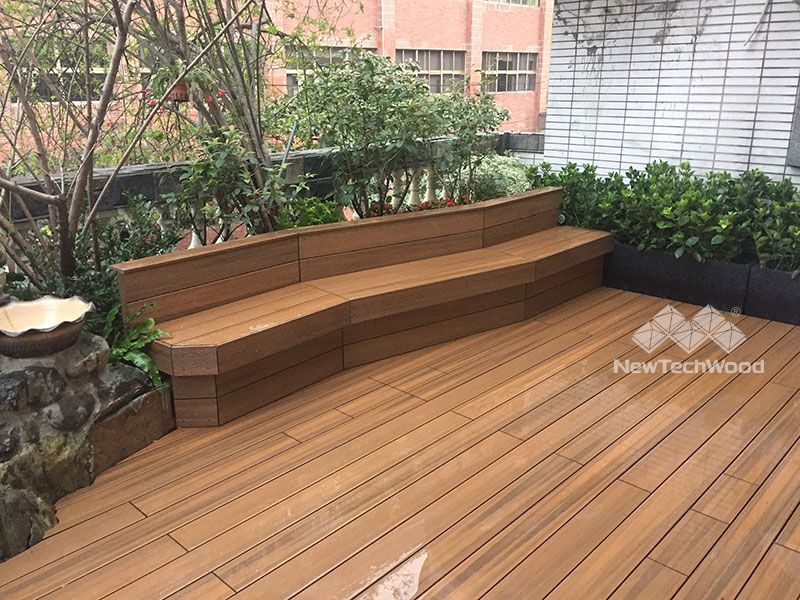
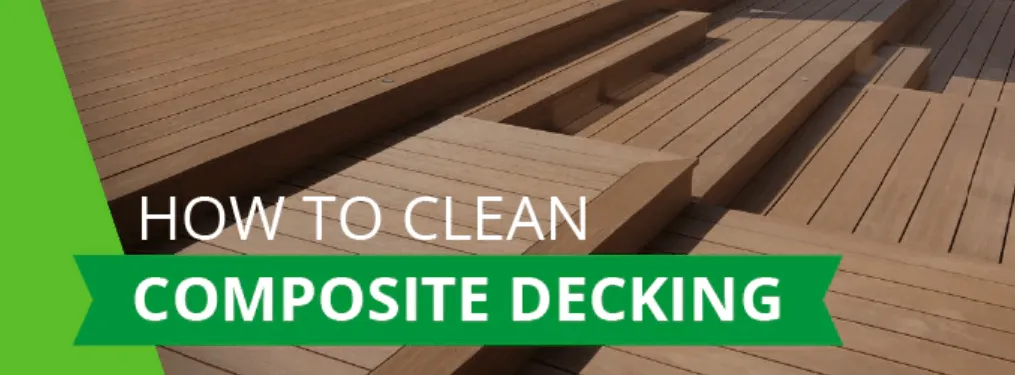
How to care for composite decking
In recent years, composite decking has become extremely popular for its beauty, durability and low maintenance. People who choose composite decking as their material get to spend more time enjoying their decks and less time maintaining them. Although this decking material is considered low maintenance, it does occasionally require maintenance and cleaning. In this guide, we’ll cover routine composite decking care, which includes sweeping it and scrubbing it with soap and water, as well as how to remove unwanted things like food stains, mold, rust and scratches.
What is composite decking made of?
Composite decking is a relatively new material, so it is understandable that many people are still unfamiliar with its composition. Learning about the materials that make up composite decking, however, will give you a better understanding of what it can and cannot withstand and how you should handle it. Composite decking is normally made from a mixture of several materials, primarily plastic and wood. These materials are processed to resemble real wood as closely as possible. The wood generally consists of byproducts in the lumber industry, including chips, sawdust and wood fiber. Both the wood and the plastic can be made from recycled or virgin material.
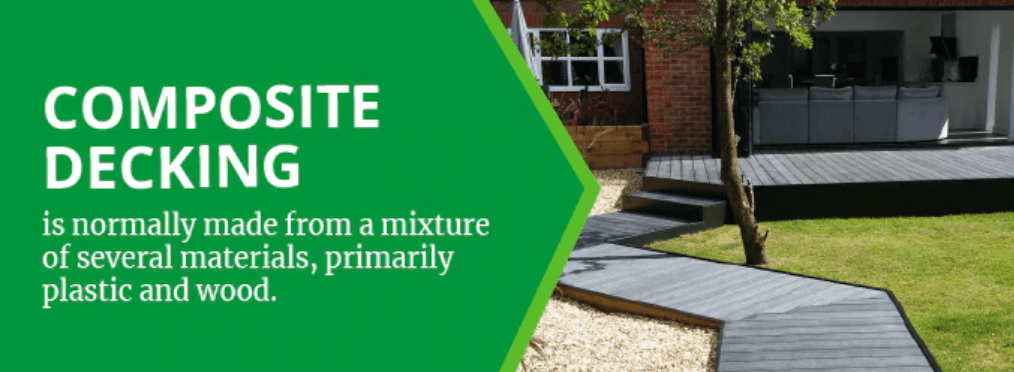
Types of composite decking
There are lots of different types of composite decking available. For example, the textured grain look gives the decking strips shallow groves resembling a tree’s natural rings, so you have a wood-like look. Other composite decking options offer you a side with grain, and one without, while weathered or embossed options might provide the look you are going for. Plastic-wrapped composite decking, or encased composite decking, is a fantastic option for longevity because it protects all sides of the board and therefore, the board’s inner core. Capping all the way around the board, including the grooves, means you have maximum protection against the typical environmental stressors deck materials face, plus age-related swelling, cracking and fading.
How to avoid staining and organic decay
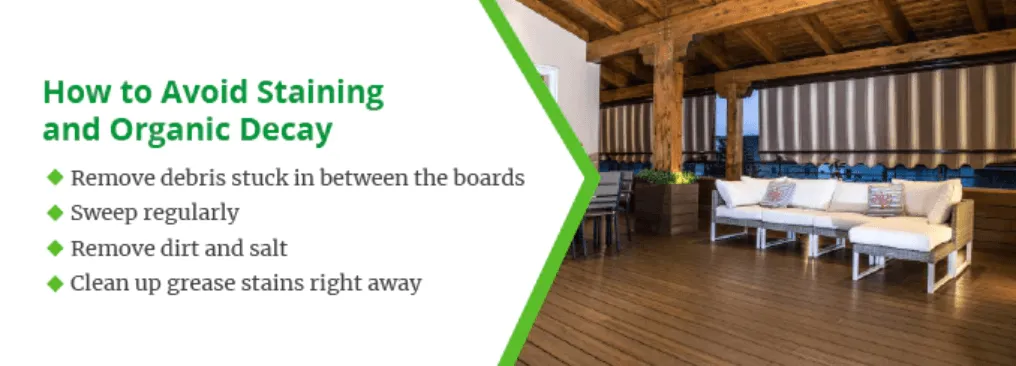
By routinely cleaning your composite decking, you can remove debris that could cause staining or organic decay. Although composite decking is designed to be stain-resistant, marks may still appear if the decking is not properly cared for. Make sure to do the following things whenever you notice debris starting to accumulate:
- Remove debris stuck in between the boards. Grass, leaves and other debris can easily make their way into the gaps between the boards. If these things become damp, it could lead to organic decay of your decking. If you notice any buildup, unclog the gaps using a putty knife or spatula. Then you can use a garden hose to spray your deck, which will rinse away anything you may have missed before.
- Sweep regularly. Sweeping your deck regularly will prevent debris from getting in the gaps. It’s especially important to keep on top of this during the fall, when falling leaves are abundant.

- Remove dirt and salt. Over time, it’s easy for dirt to accumulate on your deck. Rock salt, which is used to melt ice and snow, may also be left over from the previous winter. To get rid of these types of debris, you should begin by sweeping. If sweeping doesn’t remove all the debris, then get mild soap, water and a gentle scrub brush that has no metal. Once you’ve scrubbed the debris away, give the area a thorough rinsing.
- Clean up grease stains right away. Most homeowners occasionally use their decks for eating meals during the warmer months, and those who do will eventually end up spilling greasy food or liquids on the decking surface. While you may be tempted to wait until your next routine cleaning to remove the food, it should be done immediately or else staining might result.
How to clean food stains off of composite decking
Composite decks consist of a mix of plastic and wood, and while each brand is a little different in terms of stain and scratch resistance, durability and appearance, all brands are susceptible to oil and grease stains, which are typically caused by dropped food. If you spill grease on your decking, clean it up as soon as you can to minimize the chances of a stain. Generally speaking, the longer you wait, the harder the stain will be to remove. Follow the steps below for the best way to clean composite decking for food stains:
- Wipe. Put on some rubber gloves and try to wipe up most of the food and grease using paper towels.
- Spray. Grab a garden hose, turn it on high, and wash away more of the mess.
- Prepare a solution. Get a bucket and use it to mix hot water with some liquid dish detergent. For every gallon of water, use one tablespoon of detergent.
- Scrub. Take a nylon-bristled brush and wet it in your solution. Scrub it over the affected area to remove the grease from your decking.
- Soak with a sponge. Next, take a sponge and saturate it in the bucket of soapy water. Then, wipe the sponge over the greasy area. If the grease doesn’t come up, then pour your dish detergent onto the stain directly and leave it there for 15 to 30 minutes. Then, scrub it using your sponge.
- Sop up the grease. Use paper towels to sop up more of the soap and grease.
- Rinse. Take a water hose and spray your deck to wash away the loosened grease and soapy water. If any grease is remaining, then wash it again using soapy water until all traces have disappeared.
If you use your deck for grilling, you should put a splash mat underneath it to catch drips and splatter. This will save you a lot of cleaning! Bird droppings can be removed just like stains — with warm, soapy water.
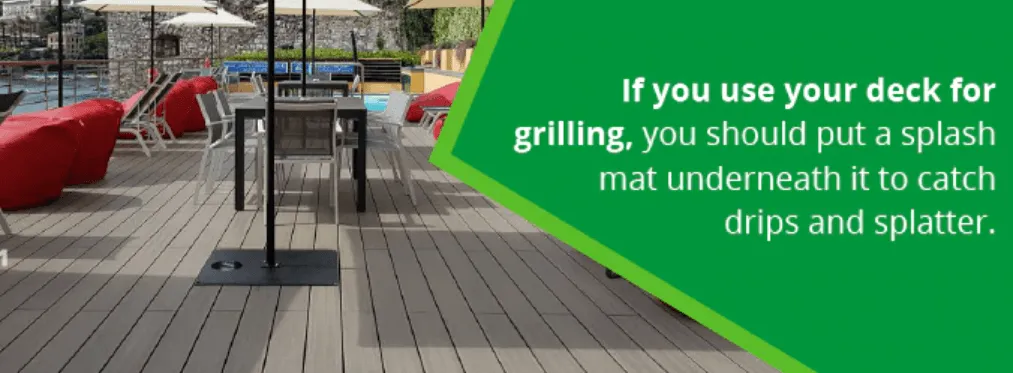
How to clean mildew and mold off composite decking
Another common issue that composite deck owners face is the growth of mold and mildew. Mold and mildew are similar in many respects — they are both types of fungus that grow and thrive in humid, moist conditions where light is minimal or non-existent. They both start growing when their spores find a suitable environment for their colonies. Both require porous material, such as wood, paper, fabric, drywall, clothing, insulation, padding or carpet. While they generally do not grow on synthetic materials such as plastic, metals and composite decking, dirt left on composite decking can feed mold and mildew spores.
Mold and mildew differ primarily in their appearance. Mildew tends to be gray or white, fuzzy or powdery in texture and is typically found on plant leaves, making the plants appear to be sick. As mildew begins to feed on the cells of the plant, gray or white splotches will emerge. Mold, on the other hand, is typically black, green or yellow, and its texture is usually slimy or fuzzy. In severe cases, mold will appear plant-like and eat away at its host.
Mold can be extremely harmful to those who are exposed to it over longer periods of time. As mold grows, the fungi release mycotoxins, which can cause various symptoms including eye irritation, skin irritation, high fevers, shortness of breath and other allergic reactions.
Mold and mildew affect the people in the vicinity in different ways. For example, people who inhale these spores might begin to cough, develop a headache or become short of breath.
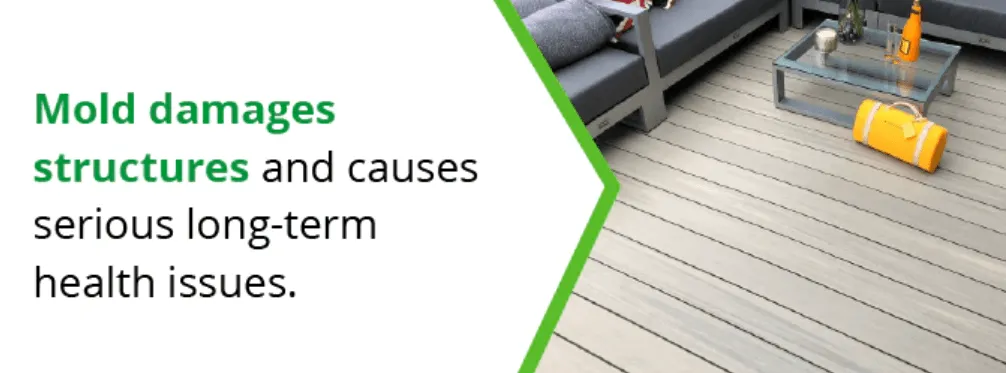
The effects of mold are generally more serious than those of mildew. Mold damage structures and cause serious long-term health issues. Reactions to this fungus include:
- Heart problems
- Breathing issues
- Migraines
- Joint pain
- Depression
- Fatigue
Furthermore, those with a mold allergy could experience sneezing, congestion and eye, skin and throat irritation. For this reason, it’s critical that you remove mold from your deck as soon as possible. While composite decking is resistant to many things, it is not impervious to mold and mildew. Luckily, removing mold from your deck is not difficult. Just follow these steps:
- Pressure wash. Using a pressure washer, remove as much of the mold as you can.
- Prepare a solution. Make a solution of vinegar and water with two-parts vinegar and one-part water.
- Pour the solution. Pour your solution on top of the moldy area, then sprinkle baking soda on top.
- Wait. Let the baking soda and vinegar sit for 20 minutes or more.
- Scrub. Take a medium-to-course bristle brush and scrub the area until you’ve removed all residual mildew and mold.
- Rinse. Using clean water, rinse the area.
How to avoid mold and mildew growth
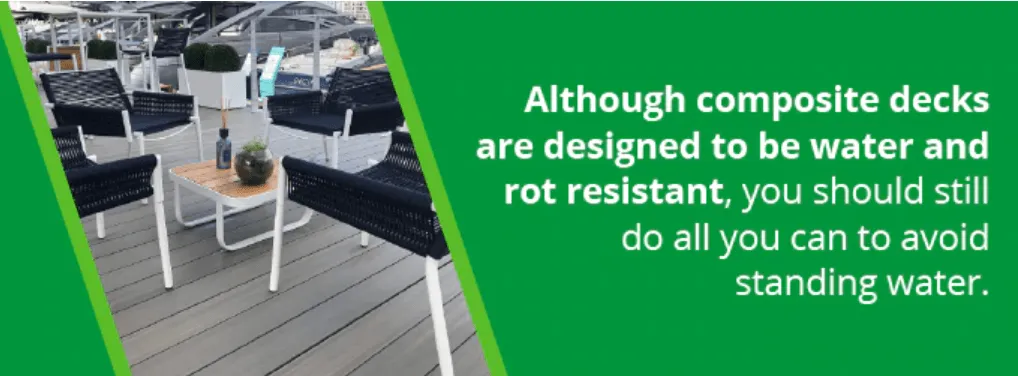
Although composite decks are designed to be water- and rot-resistant, you should still do all you can to avoid standing water. As mildew and mold are usually found outside and are dependent on air, warm weather and moisture to grow, you should minimize the chances of mold growth by:
- Ventilating under your deck: If air can circulate under your deck, your decking will dry much faster. Make sure that your deck has no fewer than 6 inches of unobstructed airflow below it.
- Redirecting your dryer vents: Dryers produce lots of heat and must ventilate the hot air outside. Make sure that your dryer vent does not open under or near your deck because the heat can increase the temperature of your decking and promote decay. Drier vents can also carry moist air, which will promote mold and mildew growth.
- Keeping an eye out for standing water: If you notice water pooling in specific places of your deck after rain, you might have to make a few adjustments. Rework your deck to allow for better drainage.
- Redirecting your downspouts: Don’t allow runoff from your roof to hit your composite deck. Make sure to direct downspouts elsewhere to keep the decking from being exposed to excess moisture.
- Keeping mulch away: If you have mulch in your yard, avoid putting it right next to your deck.
- Preventing soil overflow: If there are flowerpots on your composite decking, place them in saucers that are large enough to catch any soil or water that may overflow so that it doesn’t touch the deck surface.
- Leaving a little space between your deck boards: If you’re installing a composite deck in the future, make sure not to place the boards too close together. If the gaps are too small, they won’t let water and dirt escape once they come in.
- Using only woven rugs: Avoid using rugs or mats with a rubber backing, as these products are known to trap moisture. Instead, use rugs with a woven back, which breathe better.
- Trimming your bushes: Nearby trees and bushes should be trimmed about a foot away from your deck. This space makes it more difficult for mold to grow.
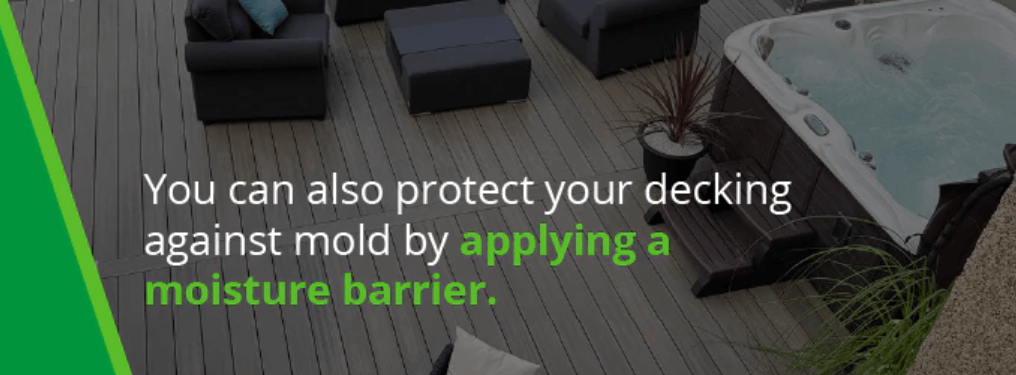
You can also protect your decking against mold by applying a moisture barrier. Choosing the right product here is essential, and when shopping, avoid any sealers that are “waterproofing” or any chemicals that “encapsulate” your material. Products like these can trap the moisture inside your deck and cause other issues in the future.
How to clean rust off of composite decking
Although composite decks are generally thought to be stain-resistant, some stains can still occur, including rust stains, which occur when a metal item remains wet on the surface of a deck. Fortunately, it’s relatively easy to remove these stains from your composite deck. Here’s what you need to do:
- Prepare a solution. Mix one half to one cup of liquid dishwashing detergent with warm water in a large container or bucket.
- Scrub. Acquire a brush with soft-to-medium bristles, dip it into the bucket and use it to scrub the stained area. Cleaning brushes with long handles are available at most home repair or hardware stores.
- Rinse. Using clean water, rinse the area until the stains disappear.
How to clean snow and ice off of composite decking
Although some homeowners don’t use their decks during the winter months, those who use their decks to access the entrances to their homes will need to keep a walkway clear. Here are some tips on how to go about it:
- Clear your deck before the snow starts. If you live in an especially snowy region, the first major snowfall of the season may be the last time you see your deck’s surface. Before this first snowfall occurs — but after most of the leaves have fallen — make sure to sweep away leaves, pine needles, acorns and other debris from your deck. You can use a leaf blower or firm bristled broom. Make sure to clear out the area between boards so that melting snow can freely flow.
- Use a plastic shovel. When shoveling snow on your composite decking, make sure that your shovel has a plastic blade, which will minimize the chance of scratching the surface of your deck. However, even some shovels made of plastic, especially ones with a hard metal blade on the edge, can cause damage to the protective shell found on certain composites and will void your warranty.
- Shovel in the right direction. Push your shovel parallel to your decking, which will keep from damaging the edges of the boards.
- Try a leaf blower. If the snowfall is just a light dusting, you may be able to avoid using a shovel altogether and get by with a leaf blower instead.
- Use salt. High-quality, properly installed composite decks should be able to withstand the weight of a large amount of snow. However, if you need to remove some snow for safety, use rock salt or a product that is calcium-chloride based to melt the snow away. When shopping, look for an ice-melt with messages like “concrete-safe” and “flagstone-safe.”
- Rinse away remaining salt. Once you have cleared all the snow from the deck, rinse off or sweep away any residue of the salt to prevent corrosion or staining.
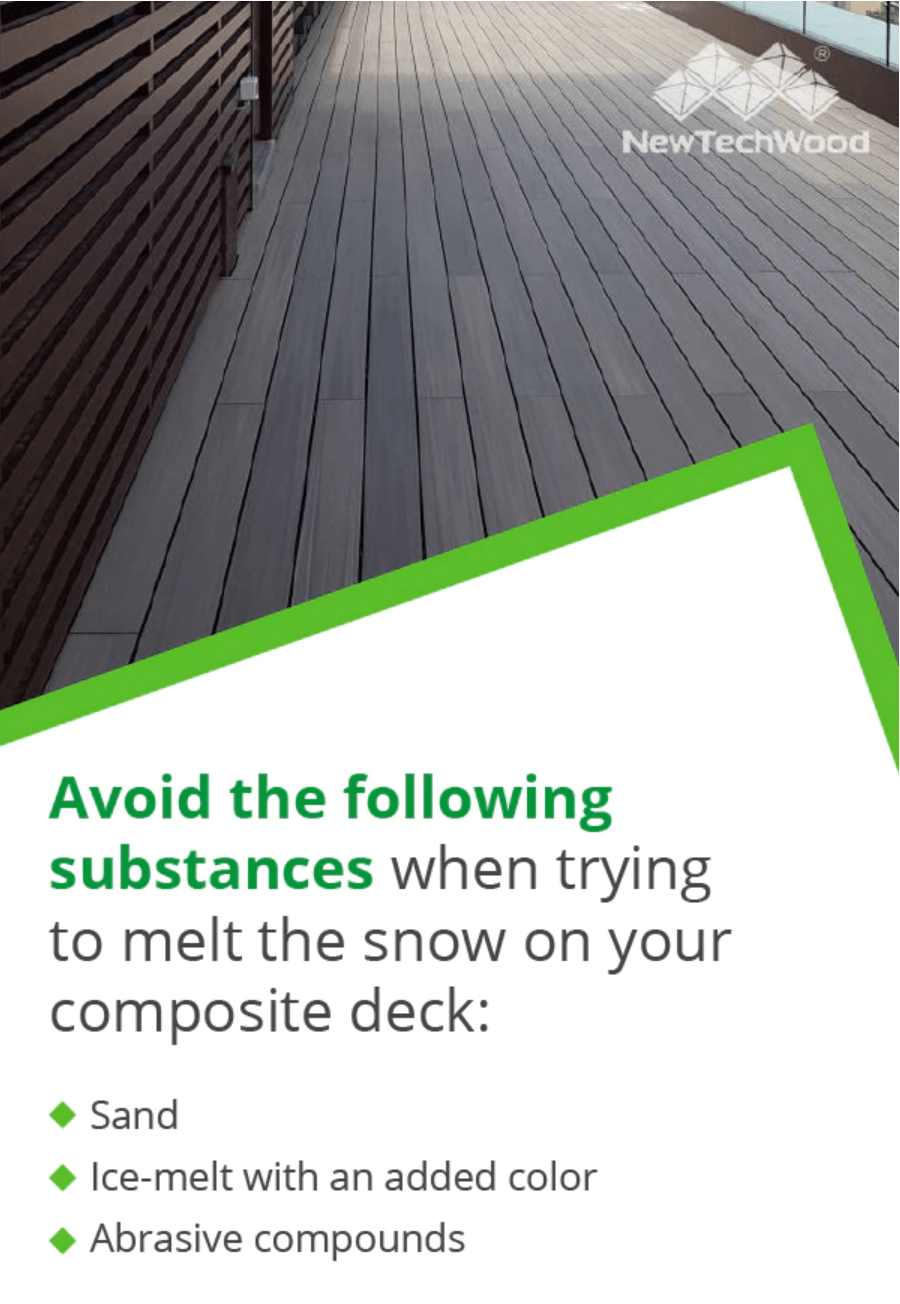
Avoid the following substances when trying to melt the snow on your composite deck:
- Sand: Although some homeowners are tempted to use sand because of the traction it provides on slippery surfaces, the foot traffic going over sand can abrade the surface of your deck.
- Ice-melt with an added color: While manufacturers sometimes add color to ice melt to help you keep track of where you’ve spread the chemical, the dyes found in these products can stain your decking.
- Abrasive compounds: This includes any compounds of basic or acidic pH, oil-based stains or paints, strong solvents and any substance that could cause metal to rust.
How to clean scratches off composite decking
Composite decking consists of recycled materials like wood and hard plastics. The material was created to extend the life of decks without the repairs that wood decks require. While you’ll never have to worry about cracking, splitting or rotting with composite decking, scratches can occur on occasion. Here is how to remove them:
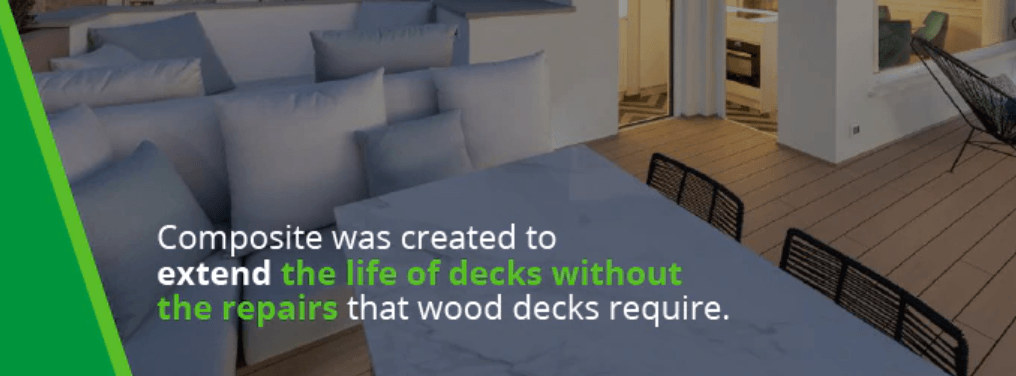
- Wait. The first thing to do is sit back and let the scratches fade naturally. With time and weather, the scratch will become less conspicuous.
- Scrape. Take a heat gun and hold it at least 7 inches away from the surface. Then, take a wire brush and use it to scrape the area you’re applying heat to. Make sure to scrape along, not against, the grain. The heat gun serves to soften your decking so that your brushing can more easily blend the scratch into the decking material. The brush will expose the non-weathered surface beneath, which will be another color. However, this surface will naturally fade in the sun over time.
- Replace boards if necessary. If the scratches on the boards are so deep that they cannot be brushed or faded out, replace those boards.
How to avoid scratches
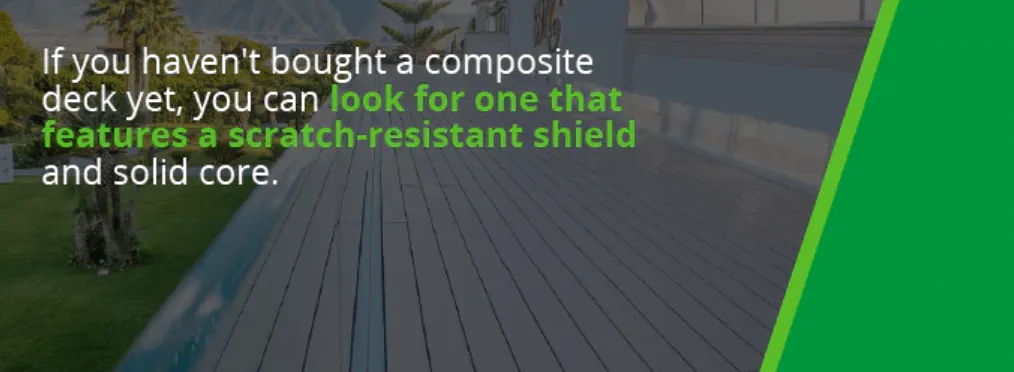
If you haven’t bought a composite deck yet, you can look for one that features a scratch-resistant shield and solid core. However, regardless of the material you pick, you can still scratch it if enough pressure and friction are applied. To minimize the chances of scratching your composite decking, use furniture pads, which are also called glides. Some furniture items already come with some form of nylon protection, whereas for others you will have to attach nylon glides to them after you buy them.
Whenever you do clean the deck, make sure to scrub in the same direction as the grain. Some people may be tempted to use rubber pads, but we discourage this as rubber can cause discoloration in some composite decking materials.
You can easily find glides in hardware stores or online. Some products simply fit over the feet of your furniture while others must be tapped with a hammer to be attached. Examine your patio table’s base and see if there is anything between the metal or hard plastic and the deck. If not, make sure to attach protecting padding. Alternatively, you can put down an outdoor carpet that goes with the style of your home.
Pressure washing composite decking
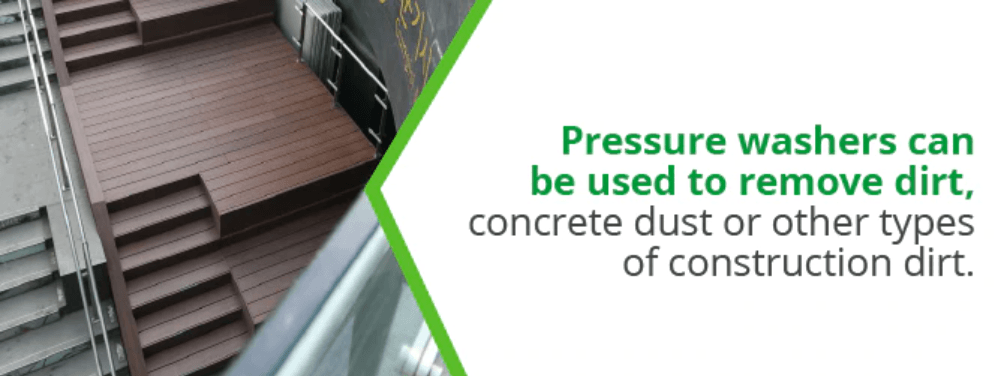
Common maintenance mistakes
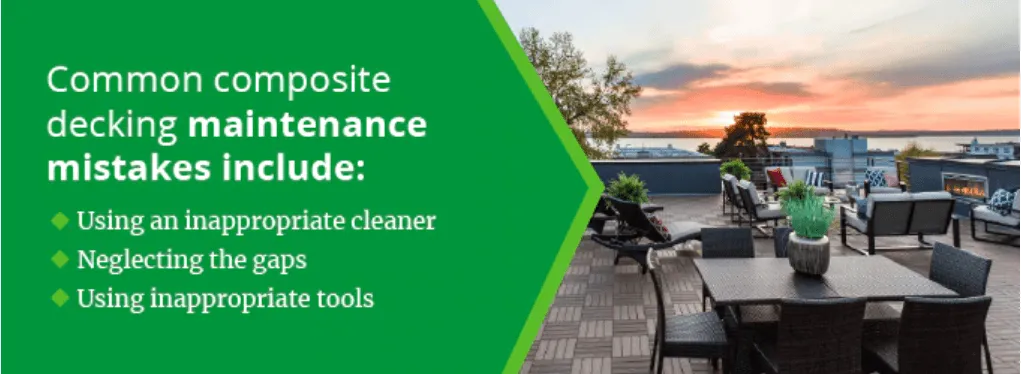
When cleaning composite decking, some homeowners make mistakes that can increase the amount of care they’ll have to perform on their deck later. Common composite deck maintenance mistakes include:
- Using an inappropriate cleaner: Selecting the right cleaner is critical. When shopping for a cleaner, make sure to look closely at the label and never choose a “deck cleaner” that is chlorine-based. If the cleaner’s active ingredients include sodium hypochlorite, this means that it has bleach. This material will severely corrode your deck, leading to damage and discoloration. It can also harm nearby plants and worsen any mold or mildew issues. To avoid this mistake, pick a cleaner that is non-toxic and sodium percarbonate based.
- Neglecting the gaps: One of the issues that composite decking owners face is the growth of mold underneath the deck, and one of the main reasons is clogged gaps between the boards. Debris often accumulates in these gaps, collects moisture and can promote mold growth. You should clear out the gaps between your boards at least once per year, although the frequency will depend on the climate of your region. Doing this will let air pass through the gaps and help keep the underside dry.
- Using inappropriate tools: While simple removal of debris and dirt calls for nothing more than a broom or garden hose, deeper cleans should only be performed with tools recommended by the manufacturer. In most cases, a gentle, soft-bristled scrub brush should be fine. If you are using the most appropriate cleaner, you won’t have to do as much cleaning. When removing snow, it is important that you use a plastic shovel — not a metal one.
Can I seal composite decking?
Sealing your composite deck is not required, although it is recommended. If you seal or stain your composite deck, you may not need to clean it again for several years. If you decide against sealing it, plan on cleaning it about once a year.
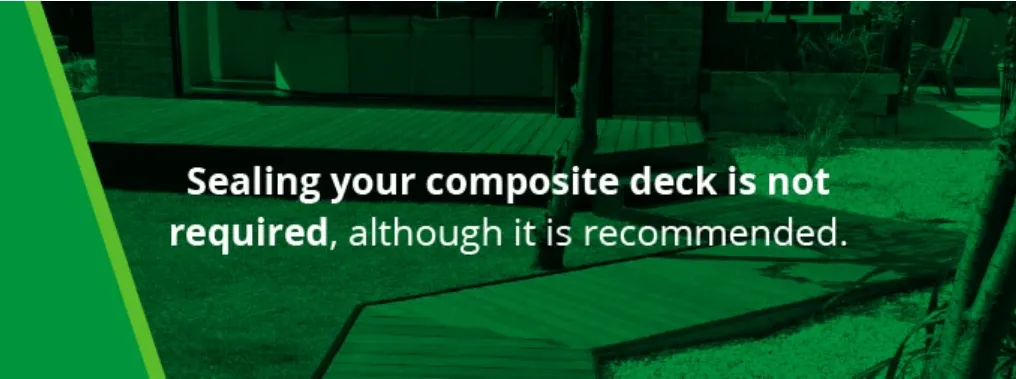
This should be performed only once the surface has been thoroughly cleaned. Here are some tips for sealing your deck:
- Choose the right stain. Selecting an appropriate stain for your composite decking is critical. When shopping for your product, make sure to look for a water-based sealer. These sealers are much better than solvents, which are more difficult to use and will often amber the color of your surface. Water-based products, on the other hand, are perfectly clear and won’t affect your deck’s color. Solvent-based products are also a food source for mildew, mold and algae. Look for water-based products that use synthetic resins, which will not allow mildew to grow, and products with zinc nanoparticles, which will help combat mold growth.
- Follow the directions closely. Although it’s tempting to start your project without reading the directions, take a few minutes to read the back of the can, which tells you everything you need to know about using the product. It will inform you about any particulars that could affect how your job turns out, including the time it takes to dry, the number of coats you should apply, the amount of time to wait between coats and whether there is a critical recoat time.
- Brushing is necessary. No matter how you decide to apply your sealer, whether it be by spraying or rolling, it must absolutely be brushed. If you first applied the sealant by rolling, then just back brush it afterward before it dries. The same applies to spraying. However, you can save yourself a lot of trouble by just using a brush to apply the sealer. The explanation is simple — when brushing the sealer, your brush creates friction on your decking surface, breaks the board’s surface tension and then works your sealer into the pores. The better you can get your surface to absorb the sealer, the longer-lasting your project will be.
- Wipe away excess sealer. This may seem counterintuitive, but if you apply more sealer than your deck can absorb, make sure to wipe away the excess. If too much sealer is applied, it will puddle on your surface and leave behind shiny spots, which will look bad. Those spots will likely flake and peel over time as well. Never apply more sealer than your decking can absorb easily.
- Let it dry. After wiping off the excess sealer, your deck is finished. Just give your deck until the day to dry. Keep your furniture out in the yard and keep your pets in the house so that the sealer has enough time to cure out.
Contact NewTechWood to learn more about our composite deck materials
NewTechWood is a leading manufacturer of composite decking, deck tiles, railing, siding and various other outdoor products. Since it was founded in 2004, NewTechWood has been a pioneer in the world of wood-plastic composite technology, developing products that offer practicality and beauty for spaces around the world.
One of the most cutting-edge features of NewTechWood products is its UltraShield® technology, which combines the sturdiness of high-density polyethylene plastic and wood fibers with an outer polymer shell that completely coats the board, offering protection against mold and mildew, scratching, staining, fading, swelling and cupping.
This premium shield encases all sides of the board around its inner core — even in the board’s groove. This is the only way that the board can be completely protected from water, UV rays, insects and mold and mildew. The core and shield are extruded together at the same time under an extremely high-temperature mold, meaning that no harmful chemicals or adhesives were used in the process.
The core consists of recycled materials and dense softwood and hardwood fibers that give the core more durability and strength. It’s also 100 percent recyclable. We are so confident in the durability and long-lasting performance of our UltraShield® decking that we offer a 25-year limited transferable warranty, which is the industry’s most comprehensive warranty. You can contact us by filling out our online form. We look forward to hearing from you!

